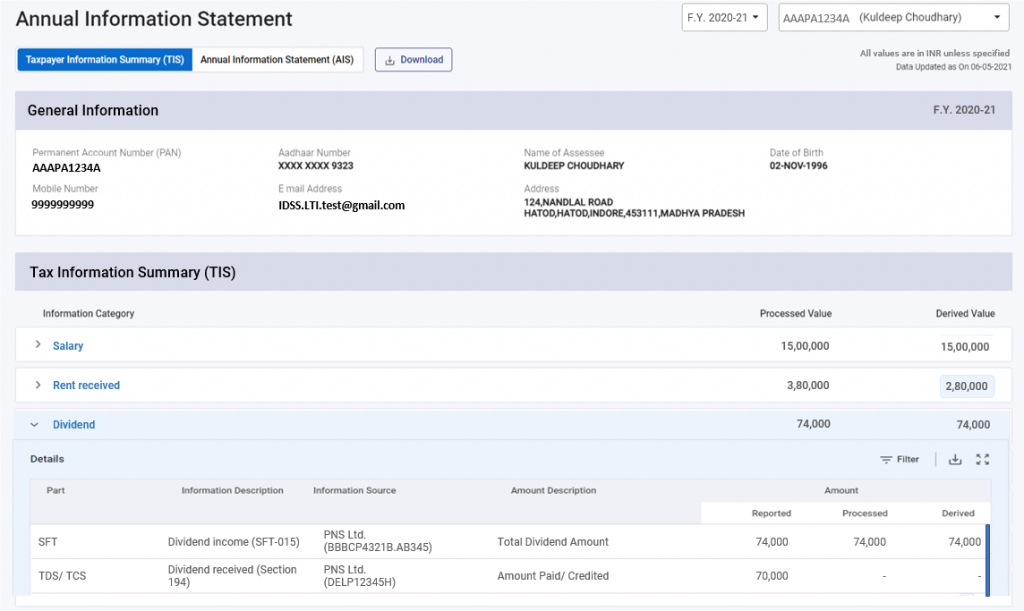
Annual Information Statement or AIS is comprehensive view of information for a taxpayer displayed in Form 26AS. During preparation of AIS, information processing is required to display complete and accurate information to the taxpayer.
1. Objectives
The key objective of AIS are:
• Display complete information to the taxpayer
• Promote voluntary compliance and enable seamless prefiling of return
• Deter non-compliance
2. AIS Features
Salient Features of new AIS are as under:
• Inclusion of new information (interest, dividend, securities transactions, mutual fund transactions, foreign remittance information etc.)
• Use of Data Analytics to populate PAN in non-PAN data for inclusion in AIS.
• Deduplication of information and generation of a simplified Taxpayer Information Summary (TIS) for ease of filing return (pre-filling will be enabled in a phased manner).
• Taxpayer will be able to submit online feedback on the information displayed in AIS and also download information in PDF, JSON, CSV formats.
• AIS Utility will enable taxpayer to view AIS and upload feedback in offline manner.
• AIS Mobile Application will enable taxpayer to view AIS and upload feedback on mobile.
| Disclaimer: Annual Information Statement (AIS) includes information presently available with Income Tax Department. There may be other transactions relating to the taxpayer which are not presently displayed in Annual Information Statement (AIS). Taxpayer is expected to check all related information and report complete and accurate information in the Income Tax Return. |
The schematic flow of information

3. AIS Preparation
Some key information processing steps are:
• PAN Population: In case no valid PAN is available in the submitted information, the PAN will be populated on matching Aadhaar and other key attributes.
• Information Display: Generally, the reported information is displayed against the reported PAN holder. The information display logic for specific information such as property, bank account, demat account etc. aims to show information to relevant PAN holders to enable review and submission of feedback
• Information Deduplication: In case where similar information is reported under different information types (e.g. reporting of interest/dividend in SFT and TDS) the information with lower value will be marked as “Information is duplicate / included in other information” using automated rules.
• Taxpayer Information Summary (TIS) preparation: The information category wise aggregated information summary for a taxpayer is prepared after deduplication of information based on pre-defined rules. It shows processed value (i.e., value generated after deduplication of information based on pre-defined rules) and derived value (i.e., value derived after considering the taxpayer feedback and processed value) under each information category (e.g., Salaries, Interest, Dividend etc.). The derived information will be used for prefilling of Return.
4. AIS Feedback
The taxpayer will be able to view AIS information and submit following types of response on the information:
• Information is correct
• Information is not fully correct
• Information relates to other PAN/Year
• Information is duplicate / included in other information
• Information is denied
• Customized Feedback
Illustrations
Illustration 1: Display of information reported under both TDS and SFT
Payment of dividend above Rs 5,000 is required to be reported under TDS Statement. Under SFT all dividend payment is required to be reported. In this case, Dividend payment of Rs 70,000 was reported by the Deductor (TAN based) under TDS and 74,000 was reported under SFT by the reporting entity.
Annual Information Statement (AIS)
TDS – Information source (L2 level)

SFT – Information source (L2 level)

Note: In AIS, TDS information and SFT information is reported under sections B1 and B2.
Taxpayer Information Summary (TIS)

Note: Information reported under TDS is marked as Duplicate during Processing.
5. AIS Information Category
The broad categories of Information in AIS summary view are as under:
The key information sources, approach for AIS processing and AIS summary preparation is explained in following paragraphs.
01. Salary
02. Rent received
03. Dividend
04. Interest from savings bank
05. Interest from deposit
06. Interest from others
07. Interest from income tax refund
08. Rent on plant & machinery
09. Winnings from lottery or crossword puzzle u/s 115BB
10. Winnings from horse race u/s 115BB
11. Receipt of accumulated balance of PF from employer u/s 111
12. Interest from infrastructure debt fund u/s 115A(1)(a)(iia)
13. Interest from specified company by a non-resident u/s 115A(1)(a)(iiaa)
14. Interest on bonds and government securities
15. Income in respect of units of non-resident u/s 115A(1)(a)(iiab)
16. Income and long-term capital gain from units by an offshore fund u/s 115AB(1)(b)
17. Income and long-term capital gain from foreign currency bonds or shares of Indian companies’ u/s 115AC
18. Income of foreign institutional investors from securities u/s 115AD(1)(i)
19. Insurance commission
20. Receipts from life insurance policy
21. Withdrawal of deposits under national savings scheme
22. Receipt of commission etc. on sale of lottery tickets
23. Income from investment in securitization trust
24. Income on account of repurchase of units by MF/UTI
25. Interest or dividend or other sums payable to government
26. Sale of land or building
27. Receipts for transfer of immovable property
28. Sale of vehicle
29. Sale of securities and units of mutual fund
30. Off market debit transactions
31. Off market credit transactions
32. Business receipts
33. Business expenses
34. Rent payment
35. Miscellaneous payment
36. Cash deposits
37. Cash withdrawals
38. Cash payments
39. Outward foreign remittance/purchase of foreign currency
40. Receipt of foreign remittance
41. Payment to non-resident sportsmen or sports association u/s 115BBA
42. Foreign travel
43. Purchase of immovable property
44. Purchase of vehicle
45. Purchase of time deposits
46. Purchase of securities and units of mutual funds
47. Credit/Debit card
48. Balance in account
49. Income distributed by business trust
50. Income distributed by investment fund


